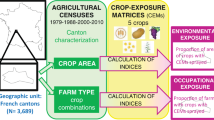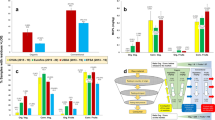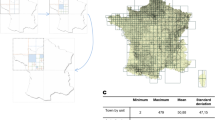Abstract
Self-reported work histories are often the only means of estimating occupational exposures in epidemiologic research. The objective of this study was to examine the accuracy of recall of historical pesticide use among orchardists. All 185 orchardists in this study had participated previously in a cohort study of men occupationally exposed to pesticides. In that study (1972 to 1976), subjects were interviewed annually and asked to list pesticides used since the last interview. In 1997, 265 of the 440 presumed-living orchardists from the original cohort were successfully recontacted and asked to complete a detailed questionnaire concerning their lifetime use of pesticides; 185 (69.8% of farmers successfully contacted) agreed. Considering the 1972–1976 data as the standard, sensitivity and specificity of recall were calculated for certain pesticides and pesticide categories. Sensitivity of recall was good to excellent (0.6–0.9) for the broad categories of insecticides, herbicides, and fungicides, for heavily used chemical classes, such as organophosphates and organochlorines, and for commonly used pesticides; it was lower and more variable (0.1–0.6) for specific pesticides. Recall specificity was greatest (0.7–0.9) for the least used pesticides and chemical classes, such as dithiocarbamates and manganese-containing pesticides, and was generally modest for the rest (0.5–0.6). There was no evidence of selection bias between study participants and nonparticipants. In conclusion, recall accuracy was good for commonly used pesticides and pesticide categories. This level of recall accuracy is probably adequate for epidemiologic analyses of broad categories of pesticides, but is a limitation for detecting more specific associations.
This is a preview of subscription content, access via your institution
Access options
Subscribe to this journal
Receive 6 print issues and online access
$259.00 per year
only $43.17 per issue
Buy this article
- Purchase on Springer Link
- Instant access to full article PDF
Prices may be subject to local taxes which are calculated during checkout


Similar content being viewed by others
References
Armstrong, B. K., White, E. and Saracci, R. Principles of exposure measurement in epidemiology. Oxford University Press, Oxford, New York. 1992.
Baumgarten, M., Siemiatycki, J., and Gibbs, G. W. Validity of work histories obtained by interview for epidemiologic purposes. Am J Epidemiol. (1983) 118: 583–591.
Blair, A., and Zahm, S. H. Patterns of pesticide use among farmers: implications for epidemiologic research. Epidemiology. (1993) 4: 55–62.
Blair, A., and Zahm, S. H. Agricultural exposures and cancer. Environ Health Perspect. (1995) 103(suppl 8): 205–208.
Bond, G. G., Bodner, K. M., Sobel, W., Shellenberger, R. J. and Flores, G. H. Validation of work histories obtained from interviews. Am J Epidemiol. (1988) 128: 343–351.
Bourbonnais, R., Meyer, F., and Theriault, G. Validity of self reported work history. Br J Ind Med. (1988) 45: 29–32.
Brisson, C., Vezina, M., Bernard, P. M. and Gingras, S. Validity of occupational histories obtained by interview with female workers. Am J Ind Med. (1991) 19: 523–530.
Dich, J., Zahm, S. H., Hanberg, A. and Adami, H. O. Pesticides and cancer. Cancer Causes Control. (1997) 8: 420–443.
Engel, L. S., Checkoway, H., Keifer, M. C., Seixas, N. S., Longstreth, Jr. W. T., Scott, K. C., Hudnell, K., Anger, W. K. and Camicioli, R. Parkinsonism and occupational exposure to pesticides. Occup Environ Med. in press
Ferguson, W. L. Pesticide use on selected crops: aggregated data, 1977–80. U.S. Department of Agriculture Economic Research Service. 1985.
Hayes, W. J., and Laws, E. R. Handbook of Pesticide Toxicology. Academic Press, San Diego. 1991.
Holmes, E., and Garshick, E. The reproducibility of the self-report of occupational exposure to asbestos and dust. J Occup Med. (1991) 33: 134–138.
Joffe, M. Validity of exposure data derived from a structured questionnaire. Am J Epidemiol. (1992) 135: 564–570.
Osteen, C. D. and Szmedra, P. I. Agricultural pesticide use trends and policy issues. Agricultural Economic Report No. 622. Economic Research Service, US Department of Agriculture, Washington, DC. 1989.
Rosenberg, C. R. An analysis of the reliability of self reported work histories from a cohort of workers exposed to polychlorinated biphenyls. Br J Ind Med. (1993) 50: 822–826.
Rosenberg, C. R., Mulvihill, M. N., Fischbein, A. and Blum, S. An analysis of the validity of self reported occupational histories using a cohort of workers exposed to PCBs. Br J Ind Med. (1987) 44: 702–710.
Stewart, W. F., Tonascia, J. A. and Matanoski, G. M. The validity of questionnaire-reported work history in live respondents. J Occup Med. (1987) 29: 795–800.
van der Gulden, J. W., Jansen, I. W., Verbeek, A. L. and Kolk, J. J. Repeatability of self-reported data on occupational exposure to particular compounds. Int J Epidemiol. (1993) 22: 284–287.
Washington State Epidemiologic Study Project. The effects of pesticide exposure on the life span of a selected segment of the population — Work Unit E-31 Final Report. U.S. Environmental Protection Agency. 1976.
Acknowledgements
This study was supported by National Institute for Environmental Health Sciences Training Grant ES07262, National Institute for Occupational Safety and Health-Supported PNASH grant U07/CCU012926-02, and by the Worker's Compensation Fund of the State of Washington, which is administered by the Washington State Department of Labor and Industries.
Author information
Authors and Affiliations
Corresponding author
Rights and permissions
About this article
Cite this article
ENGEL, L., SEIXAS, N., KEIFER, M. et al. Validity study of self-reported pesticide exposure among orchardists. J Expo Sci Environ Epidemiol 11, 359–368 (2001). https://doi.org/10.1038/sj.jea.7500176
Received:
Published:
Issue Date:
DOI: https://doi.org/10.1038/sj.jea.7500176
Keywords
This article is cited by
-
An interdisciplinary method for assessing IPM potential: case study in Scottish spring barley
CABI Agriculture and Bioscience (2022)
-
Domestic use of pesticides during early periods of development and risk of testicular germ cell tumors in adulthood: a French nationwide case-control study
Environmental Health (2021)
-
Occupational exposure to pesticides: development of a job-exposure matrix for use in population-based studies (PESTIPOP)
Journal of Exposure Science & Environmental Epidemiology (2018)
-
A French crop-exposure matrix for use in epidemiological studies on pesticides: PESTIMAT
Journal of Exposure Science & Environmental Epidemiology (2017)
-
Organic solvent exposure and depressive symptoms among licensed pesticide applicators in the Agricultural Health Study
International Archives of Occupational and Environmental Health (2017)



